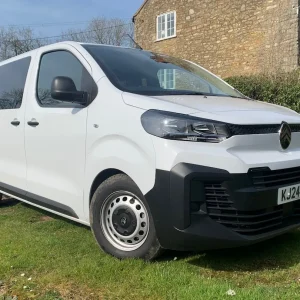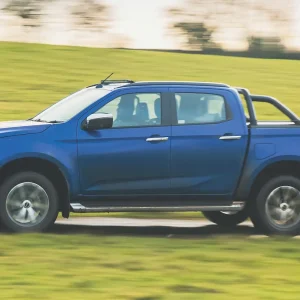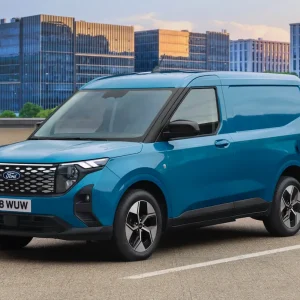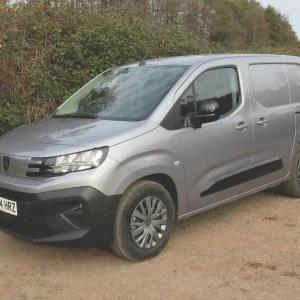In the mid-term, the target is to double sales in Europe to 100,000 units by 2014. The company believes this is achievable because it claims to have the widest range of CVs on offer, most of which are built in Europe – predominantly in Barcelona, Spain.
The brand is also confident that by 2016 more than one-in-five of all the vehicles it sells will be light commercials.
“These are ambitious plans,” admits Sergio Alcaraz, vice-president LCVs,“but they will be achieved. Nissan currently has the widest range of LCVs on the market. There are new and innovative products such as the NV400, Primastar and Cabstar vans and top-selling pick-ups like Navara. All are fully Euro5-compliant and all have been designed to deliver exactly what customers want and need.
“But this is just the start. New models, often exploring new segments and delivering new innovations, are just around the corner.”
Heavyweight contender
In the meantime, Nissan expects its newly launched heavy LCV, the NV400, to kick-start its growth plans.
The model, which was first revealed at the Hanover commercial vehicle show in September 2010, is an extremely close relation to Renault’s Master due to the joint ownership arrangement between the two manufacturers, and also has more than a little in common with the Movano, thanks to its maker Vauxhall’s longstanding collaboration with the French brand. But as UK marketing boss Francis Bleasdale says, “Many customers don’t know or care about alliances,” arguing that they are more concerned with getting the right van for the job and the best possible service from their dealer.
The NV400 is available in front-wheel drive from 2.8-3.5 tonnes and in rear-wheel drive mode for the first time from 3.5-4.5 tonnes.
According to Nissan, there are 20 versions of the NV400 panel van available with 10 load volumes ranging from 8-20m³. There are also nine body conversions up for grabs. The new 2.3-litre diesel engine (developed by Renault and replacing the 2.5 used in the Interstar) comes with 100,125 and 150hp power outputs.
“The potential for complexity is enormous,” says Bleasdale, but he also points out that Nissan has kept the specification choice for the UK simple with just entry-level E and the “big volume” SE available.
ESP is fitted as standard to all RWD models and as an option on FWD. According to Bleasdale, all SE NV400s have either reversing cameras or reversing sensors. If taken as an option, the camera
will set you back £438 excluding VAT, and if you need sensors on the basic E model you’ll have to pay £304.
Bleasdale names the competition as the Iveco Daily, the Ford Transit and the Mercedes Sprinter, and says bullishly: “We are going after them.”
He predicts sales of 1500 NV400s in a full year out of a 2012 total for the brand of 11,000 units.
We drove the 3.5-tonne, FWD 125hp, 2.3-litre, medium wheelbase, medium roof SE with semi- automatic, or ‘Robotised’ transmission. This version has a load volume of 10.8m³, which matches the Nissan’s Renault Master and Vauxhall Movano siblings and at least holds its own against equivalent Ford Transits and Mercedes Sprinters. Payload is a hefty 1620kg and the maximum braked trailer weight is 2500kg.
The cargo area is accessed through 270º twin rear doors, as well as sliding near and offside doors through which you can slot a standard Euro pallet. The offside sliding panel door comes as an option for £370.
Two-footed challenge
While the two-pedal system feels a bit lurchy at first, once you get the hang of the semi-auto shift it is pleasantly smooth and a good deal more efficient than some of its forerunners on the market.
Nissan had strapped a couple of bags of sand in the back and no doubt this contributed to a comfortable, sure-footed ride.
Power steering is reassuringly steady and predictable and results in responsive handling when one ventures onto more challenging, winding roads where it is consistently stable when cornering. And with 310Nm of torque from 1250rpm to 2500rpm the 125hp unit is no sluggard on the motorway either. Once the semi-auto box has hit top gear it can cruise along happily for as long as the route requires.
Another plus point is that noise levels inside the cab are well suppressed, which helps to minimise fatigue on long journeys.
Sitting on a waterbed
A feature that takes some getting used to is the suspended airsprung driver’s seat that initially feels like driving while strapped to a waterbed. Fortunately, the seat can be adjusted and the sensation toned down.
Nissan claims the L2H2 van we tested turns in a respectable 34.0mpg on the combined cycle while emitting CO2 of 221g/km.
Although it is based on architecture common to the Renault Master, the NV400 has a stylish and distinctive look for a heavy van that also ties it in visually with its baby brother,
the NV200, and the company’s 4×4 models due to what the manufacturer calls its “balanced angle strut” appearance.
Everything in front of the windscreen is unique to Nissan, including the bonnet, front wings, grille and front bumper. The headlights, complete with integrated running lights, are also exclusive to the NV400.
Of the styling, Sebastien Danvel, Nissan Europe’s CV marketing boss, states: “The bold Nissan look helps us differentiate the NV400 from its competitors,” which inevitably include the vans that share its DNA – the Renault Master and Vauxhall Movano.
A great deal in common
When a replacement for the NV400’s predecessor, the Interstar, was first mooted, Nissan had been expected to go its own way. It is perhaps a result of the constraints of the economic downturn that the newcomer has so much in common with its partner, Renault’s product. Nevertheless, the Japanese brand is keen to point out the NV400 is available in a far larger and more versatile range than the 2.5-litre Interstar, which came only in FWD mode.
From April, as well as the factory-built panel vans and combis, there will be crew vans, box bodies, tippers and dropsides built in-house. In addition, Nissan will offer a specialist chassis cab for conversion companies.
Vice-president LCVs, Alcaraz, says: “The NV400 is very versatile and offers a solution to each need in the heavy van sector. It is much more than a replacement for Interstar and takes us into a much wider market segment thanks to the great breadth and depth of the range.”
He also points out that FWD versions offer a lower kerb weight, enabling higher payloads, a lower frame height and better fuel economy while RWD derivatives provide a greater choice for chassis cab conversions and are available with single or twin rear wheels.
The NV400’s suspension features a Macpherson strut independent system at the front with an anti-roll bar. FWD models have single leaf spring suspension at the rear while RWD vans have either dual or triple leaf springs depending on whether they are single or twin rear-wheel versions.
Service intervals for the NV400 are set at two years or 25,000 miles and the warranty is for three years.
Like the Renault Master and Vauxhall Movano, one of the NV400’s strongest points is its cabin layout. It is 5.7cm longer than the Interstar to create extra leg room, while the seats are also longer and wider than before and come with an arm rest.
The steering wheel and driver’s seat are height adjustable. Kit available on the NV400, which would not look shabby on a passenger car, includes the Nissan Intelligent Key, automatic air conditioning, automatic lights and wipers, daytime running lights and cruise control.
Bluetooth and iPod connectivity are also an option and Nissan Connect, a satellite navigation system developed in conjunction with TomTom, which includes Google Local Search, is on offer too.
Interior storage space is more than ample and could leave those of a forgetful disposition searching for carefully stashed items for weeks on end. There are under seat compartments, numerous cup holders, plentiful door pockets and our van included a chilled glove box and a folding centre seat incorporating a swiveling table on the backrest.
Finally, the cargo area can be ordered with wood side paneling and floor trim for added protection and lashing hooks are provided on the floor and in the C and D pillars.
Verdict
The Nissan NV400 is a stylish, sophisticated vehicle that can give the segment leaders a run for their money. However, it may have lost ground to its close relative, the Renault Master, by lagging behind it in coming to market.





